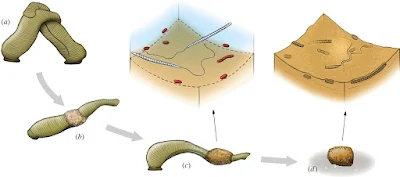Tα διατηρημένα σπερματοζωάρια έχουν μήκος
μερικά μικρόμετρα ή εκατομμυριοστά του μέτρου. 50-million-year-old
spermatozoan entrapped on the inner surface of a cocoon wall from Antarctica
(Photo: Department of Palaeobiology, Swedish Museum of Natural History).
Δείγματα
από τα παγωμένα εδάφη της Ανταρκτικής έκρυβαν τα αρχαιότερα απολιθωμένα
σπερματοζωάρια που έχουν βρεθεί μέχρι σήμερα, ηλικίας 50 εκατομμυρίων ετών.
Προέρχονται από κάποιο προϊστορικό σκουλήκι που μάλλον σχετίζεται με τους
γεωσκώληκες και τις βδέλλες, λένε οι ερευνητές.
Scanning electron
micrographs of the Antarctic annelid-cocoon fossils showing cocoon structure
and included spermatozoan fragments and bacteria (a–j), with images of extant
branchiobdellid spermatozoa for comparison (k–n). Image and caption: B.
Bomfleur et al., 2015.
Τα
σπερματοζωάρια, ορατά μόνο στο ηλεκτρονικό μικροσκόπιο, βρέθηκαν μέσα σε μικρά
απολιθωμένα κουκούλια, όμοια με τα κουκούλια που παράγουν ορισμένοι
δακτυλιοσκώληκες, αναφέρει η ερευνητική ομάδα του Σουηδικού Μουσείου Φυσικής
Ιστορίας στη Στοκχόλμη.
Diagram
illustrating the inferred mode of fossilization of microorganisms in clitellate
cocoons, exemplified by a common medicinal leech (reproductive stages modified
from Sims). (a) Two leeches mate; (b) a cocoon is secreted from the clitellum;
(c) eggs and sperm are released into the cocoon before the animal retracts and
eventually deposits the sealed cocoon on a suitable substrate (d). Insets
depict enlargements of the inner cocoon-wall surface showing how spermatozoa
and microbes become encased in the solidifying inner cocoon wall. Credit: Biology Letters, DOI:
10.1098/rsbl.2015.0431
Πολλοί
δακτυλιοσκώληκες, όπως οι γεωσκώληκες και οι βδέλλες, αποθηκεύουν τα ωάρια και
τα σπερματοζωάριά τους μέσα σε μια δομή σαν κουκούλι που ονομάζεται
δακτυλιοειδής ωοφόρος σάκος. Όταν αυτός ο σάκος ξεραθεί και σκληρύνει
δημιουργεί ένα ασφαλές περιβάλλον για την επώαση των εμβρύων.
The granular
texture of the fossilised sperm resembles the 'drill-bit' type spermatozoa of
the leech-like 'crayfish worm' in the class Branchiobdellida
(sperm pictured for comparison). This similarity helps the researchers
identify which animal the cocoon belonged to and reveals clues about its
evolutionary history.
Το
πρόβλημα, επισημαίνουν, είναι ότι τα απολιθωμένα σπερματοζωάρια μοιάζουν ίδια
με αυτά που παράγουν κάποιοι δακτυλιοσκώληκες του βορείου ημισφαιρίου, οι
οποίοι παρασιτούν αποκλειστικά σε καρκινοειδή του γλυκού νερού.
Στην
Ανταρκτική βρέθηκαν τα αρχαιότερα απολιθωμένα σπερματοζωάρια που ανήκαν σε
κάποιο προϊστορικό σκουλήκι. The fossil Clitellata cocoons were collected from deposits
of the La Meseta Formation, on the Marambio Island in the Antarctic Peninsula (marked).
Citellata is a class of annelid worms that includes earthworms and leeches. The
age of this deposit is approximately 50 million years and dates back to the
Early Eocene.
Πώς
λοιπόν μπορεί να βρέθηκαν από το βόρειο ημισφαίριο στην Ανταρκτική; Απάντηση
ακόμα δεν υπάρχει, θα μπορούσε όμως να προκύψει από τη μελέτη των απολιθωμάτων
με όργανα υψηλής ανάλυσης.
Τα
αποτελέσματα θα έριχναν φως στην εξέλιξη μιας εξαιρετικά μεγάλης ομάδας
σκουληκιών με περίπου 17.000 σύγχρονα είδη. Η μελέτη δημοσιεύεται στην
επιθεώρηση Biology Letters.






Δεν υπάρχουν σχόλια:
Δημοσίευση σχολίου